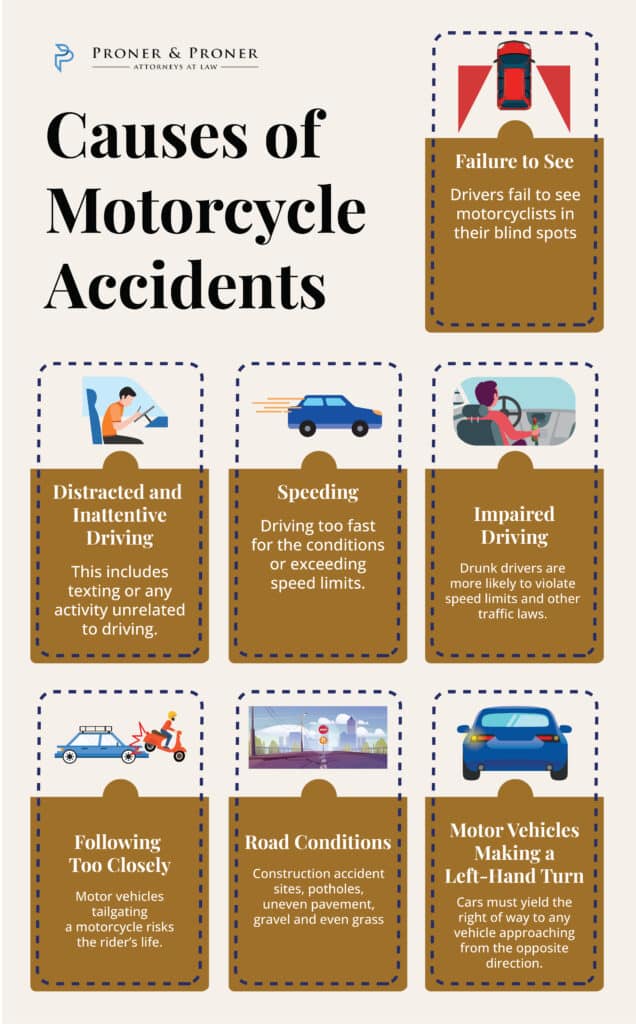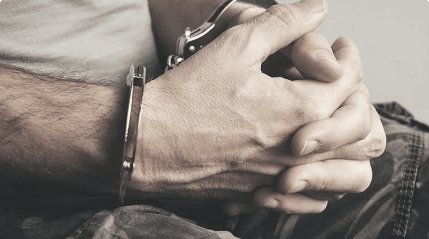New York City Motorcycle Accident Lawyer
Home » New York City Personal Injury Lawyer » New York City Motorcycle Accident Lawyer
- Why Proner & Proner?
- What should I do if I have been in a motorcycle accident?
- How much does a motorcycle accident attorney cost?
- Types of Motorcycle Accident Compensation
- Causes of Motorcycle Accidents
- Get Advice From An Experienced Motorcycle Accident Lawyer
- Motorcycle Accident Injuries
- When should I contact Proner & Proner?
- Who is liable for my motorcycle accident injuries?
- What if I am partly at fault for the accident?
- FAQs About Motorcycle Accidents
- Do I need an attorney for my motorcycle accident case?
Why Proner & Proner?
The skilled attorneys at Proner & Proner are fervent advocates for motorcycle riders and will use their wealth of resources and years of trial experience to fiercely defend the rights of the biker community.
When our motorcycle accident law firm accepts your case, we assign a team of qualified paralegals, attorneys and support staff to provide dedicated service and communicate promptly about case developments. Our clients receive direct access to Mitchell Proner, as our team works under his immediate supervision.
You can contact our East 42nd Street office in Manhattan at (212) 986-3030 for legal assistance 24 hours a day, 7 days a week.
A Lawyer Who Understands
As a passionate rider for over 25 years, Mitchell Proner knows how motorcycle accident victims feel. In 1990, he suffered serious injuries in a motorcycle crash himself, including multiple broken bones in his back, wrist and ankle. Not to be deterred, he has since ridden more than 120,000 miles on his 1993 Harley-Davidson Heritage Softail and 2018 Harley-Davidson Road Glide.

A Reputation of Excellence in the Legal Community
Mitchell Proner’s dedication to his clients has won him the respect and admiration of his peers and the public. He makes regular appearances on major news networks in the United States and throughout the world and has received multiple prestigious accolades from the legal community, including:
- President of the New York State Academy of Trial Lawyers
- American Trial Lawyers Association’s Top 100 Trial Lawyers since 2009
- Super Lawyer designation
What should I do if I have been in a motorcycle accident?
After a motorcycle accident, the following steps will help you protect yourself and your case:
- If possible, move your motorcycle out of the roadway.
- Seek immediate medical attention, remembering that some injuries may not be readily apparent.
- If possible, take pictures and record video footage of the accident.
- Obtain the names and addresses of witnesses.
- Exchange insurance information with the other driver.
- File a police report and request a copy of the report.
- Contact Proner & Proner as soon as possible.
After an accident, DO NOT do any of the following:
- Admit fault or discuss the accident with the driver.
- Speak to the driver’s insurance company.
- Sign any documents or agree to any settlement without your attorney present.
- Delay contacting an attorney.
Related Pages
New York Office
122 E. 42nd St #2015, New York, NY 10168
Email: info@prolaw1.com
Phone: (212) 986-3030
Successful Cases
$6,900,000.00
Female, Male: Premises Liability
$3,500,000.00
Female, 43: Premises Liability
$3,500,000.00
Female, 33: Serious Personal Injury
Testimonials
Got into a motorcycle accident and went to Proner&Proner. I received great services and excellent results, I would definitively recommend the services. It was a great experience for me, A++ attorneys.
– GOOGLE REVIEWER / CLIENT
When I felt I needed legal support after a motorcycle accident, I sought out an attorney who was a motorcyclist as well. Fortunately, I found Mr. Proner. The concern I received was a comfort. The firm’s contact with me while working on my behalf was reassuring and the results certainly made a bad experience easier to put behind me. My gratitude to Proner & Proner.
– GOOGLE REVIEWER / CLIENT
Mitchell Proner is an amazing and very experienced trial lawyer, who takes care of his clients. He represented me in a car accident case, kept me very informed during the lengthy legal process and got me the settlement that I expected. His friendly office staff was always willing to assist and answer any questions I had. I recommend Mitchell Proner to all my friends and family!
– GOOGLE REVIEWER / CLIENT
I am very grateful for the services they were very quick and they dealt with my case right away. Thank you very much.
– GOOGLE REVIEWER / CLIENT
Mitchell Proner is an excellent lawyer. He took our case and did the right thing. We recommend him 100% to anyone. His staff are professionals and they care about their clients.
– GOOGLE REVIEWER / CLIENT
Greatest Lawyers I ever had. Answer any and every question I ever had. They treated me as one of the family. I can’t say enough about this firm. Thank you so much for all you guys did.
– GOOGLE REVIEWER / CLIENT
Awesome experience, excellent service, very professional and fast resolving my case. My number one attorney – definitely recommended more than once. Thank you!
– GOOGLE REVIEWER / CLIENT
What Our Clients Say
Here are some of our clients’ testimonial videos
How much does a motorcycle accident attorney cost?
At Proner & Proner, we do not charge upfront fees to our clients. We get paid only after you get paid. You have nothing to lose by contacting us. The initial consultation is free, and the statute of limitations has already begun to toll. Contact us today to schedule your free case evaluation.
Types of Motorcycle Accident Compensation
A motorcycle accident can leave you with a lengthy recovery time, chronic pain, disfigurement and permanent disabilities. You may have lost a loved one. You may feel overwhelmed with medical bills and uncertainty about your future. Fortunately, substantial compensation may be available.
Economic Damages
Also known as special damages, these are the verifiable monetary damages that stem from the accident, which include but are not limited to the following:
- Property damage
- Medical expenses
- Lost wages
- Lost business opportunities
- Loss of earning capacity
- Funeral and burial expenses (in cases of wrongful death)
Non-Economic Damages
Also known as general damages, non-economic damages are the subjective, non-monetary damages that stem from the accident, which include but are not limited to:
- Mental anguish
- Pain and suffering
- Disfigurement
- Loss of enjoyment of life
- Loss of consortium
- Loss of society
- Loss of companionship
Punitive Damages
Also known as exemplary damages, punitive damages are awarded as a punishment for the at-fault party’s conduct. These types of damages are often awarded in cases of drunk driving.
Causes of Motorcycle Accidents
Motorcycle riders have the same rights to use the roadways as passenger vehicle drivers. This means all drivers owe motorcyclists a duty of care. According to the report Motorcycle Safety by the NHTSA, motorcyclists are 28 times more likely than passenger vehicle occupants to die in a crash.
Failure to See
Motorcycle accidents involving another vehicle often occur because drivers fail to see them. According to the National Highway Traffic Safety Administration (NHTSA)
Accidents also occur when drivers fail to see motorcyclists in their blind spots. Even the most attentive drivers may fail to see motorcycles if they do not make a conscious effort to watch for them, as is their duty.
Left-Hand Turn Accidents
42 percent of fatal two-vehicle motorcycle crashes in 2020 occurred when another vehicle was turning left and the motorcycle was going straight.
It is important to remember that if you were hit by another motorist making a left turn, it is very rarely you who has made the mistake. This means you may be entitled to compensation.
Distracted and Inattentive Driving
Distracted and inattentive drivers create unnecessary risks for all roadway users. According to the NHTSA, distracted driving was responsible for 3,142 accident fatalities and 324,652 injuries in 2020. Any activity that takes the driver’s attention away from driving is a distraction. This includes texting, talking on a cell phone, eating, adjusting the radio or any activity unrelated to driving.
Motor Vehicle Speeding
According to the NHTSA, speeding contributed to 11,258 traffic fatalities across the United States in 2020, accounting for 29 percent of all accidents. In New York, speeding was identified as a contributing factor in 378 traffic fatalities, or 36 percent of all traffic fatalities. Speeding is defined as racing, driving too fast for the conditions or exceeding the posted speed limits.
Impaired Driving
Alcohol impairment is a significant contributing factor in motorcycle accidents. According to the NHTSA, drunk drivers killed 11,654 people in the United States in 2020, a rate of approximately one person every 45 minutes or 32 people per day. Drunk drivers are less likely to see motorcyclists and are more likely to violate speed limits and other traffic laws.
Following Too Closely
Following any vehicle too closely can cause an accident if the vehicle in the front brakes suddenly. While this may only risk a minor fender bender with a passenger vehicle, rear-ending a motorcycle can result in life-threatening injuries for the rider.
Motorcycle riders are are more vulnerable to road hazards and may need to make fast adjustments to their speed or lane position to avoid debris or other objects that are not hazardous to motor vehicles. Tailgating a motorcycle risks the rider’s life.
Road Conditions
Motorcycles are much more vulnerable to hazards on the roadway including construction accident sites, potholes, uneven pavement, and gravel.

Get Advice From An Experienced Motorcycle Accident Lawyer
All You Have To Do Is Call 212-986-3030 To Receive Your Free Case Evaluation.
Motorcycle Accident Injuries
Motorcycles lack crash protection, meaning riders will most likely be exposed to the road in the event of a crash. They can become pinned beneath the motorcycle or other vehicle. They may slide along the road or be hit by large and fast-moving objects. These scenarios can result in devastating injuries, including the following:
- Road rash
- Spinal cord injury
- Head injuries, including traumatic brain injury
- Lower body injuries
- Bone fractures
- Soft tissue injuries
- Loss of limbs
- Paralysis
- Disfigurement
- Death
When should I contact Proner & Proner?
It is important to contact an experienced motorcycle accident attorney as soon as possible after the accident. The state of New York imposes a three-year statute of limitations on personal injuries, or two years in wrongful death cases. While this may seem like sufficient time, your lawyer will need to accomplish several tasks before filing the lawsuit, including but not limited to the following:
- Complete a forensic analysis of the accident
- Interview witnesses
- Retain and consult with expert witnesses
- Request and review medical records
Contacting a lawyer early in the process will ensure evidence is still easily obtainable and that your attorney has access to witnesses while they can still recall important details. It will also ensure all these tasks can be completed well ahead of filing deadlines.
Who is liable for my motorcycle accident injuries?
Any party whose breach of a duty of care caused or contributed to the accident may be liable.
Other Drivers
Failing to see a motorcyclist does not absolve a driver of liability in a crash, even if the driver was paying attention and following traffic laws. Drivers owe motorcycle riders a duty to watch for them, and failure to do so makes them liable when accidents occur.
Vehicle Owners
If the negligent driver does not own the vehicle, you may have a case against the owner, which may be a trucking company, employer or private individual.
Motorcycle Manufacturers or Parts Manufacturers
Faulty components on a motorcycle, such as tires or engine parts, can be deadly, and the manufacturer is liable for any defects that cause or contribute to accidents.
The City of New York
Negligence by the City of New York to properly maintain the roadways entitles motorcycle accident victims to file a claim against the City.
Motorcycle Mechanics
If your accident was caused by an improperly installed component, or if this in any way contributed to the accident or increased your injuries, the mechanic could be liable.
Premises Owners
If your accident occurred on private property due to hazardous conditions that the owner knew or should have known existed, such as a poorly maintained parking lot, the owner may be liable.
What if I am partly at fault for the accident?
You may have been told that you are at fault or partly at fault in your accident. However, this may not be accurate. At Proner & Proner, we complete our own forensic analysis and refute the initial assessment by law enforcement when applicable.
If you do share fault in the accident, this does not bar you from recovering compensation. New York’s contributory negligence law allows accident victims to recover compensation even if they were partly at fault. However, the compensation will be reduced in proportion to your share of the fault.
FAQs About Motorcycle Accidents
Here are some answers to Frequently Asked Questions about motorcycle accidents and injuries in New York.
One of the best ways to protect yourself against injury in a motorcycle crash is to wear proper safety equipment. High-quality safety gear can significantly reduce the risk of injury for motorcycle riders. So, consider wearing a helmet, goggles, a mouthpiece, gloves, boots, knee pads, hip pads, and a motorcycle jacket when you ride your bike.
A helmet that covers your entire face will protect you against traumatic brain injury, goggles will shield your eyes from the elements while you ride and ensure that your vision is unblocked, gloves will prevent lacerations to your hands if you are thrown from your bike or if the bike skids on the roadway, and a motorcycle jacket with bright colors will protect your upper body against injuries in a crash and make you more visible to other motorists on the road or highway.
Additionally, since NY law requires motorcycle riders to wear helmets, the failure to wear a helmet could affect your ability to win an accident claim if you do sustain injuries in a motorcycle crash.
Whether you were involved in a single-vehicle accident, a head-on collision with another motor vehicle, a hit-and-run accident, or any other type of motorcycle accident, the most important thing for you to do immediately after the crash is to get to a safe place on the road (or off the road).
Next, you need to get proper medical treatment for your injuries. And remember that some injuries aren’t always apparent right after the motorcycle accident and may take days or even weeks to become obvious, so make sure that you see a doctor and get checked out just to be sure.
You should also report the motorcycle accident to the police and get a police report. This will ensure that everything is documented for your accident claim with the insurance company and for court if the case eventually goes to trial.
Once you have taken care of your physical well-being and reported the accident to the police, protect yourself legally and speak to an experienced motorcycle accident attorney at Proner & Proner. Do not talk to the other motorist or to the insurance company before talking to a qualified attorney who can explain your legal options and make sure that you do not make any unnecessary admissions to the insurance adjustor.
Unfortunately, a lot of vehicle insurance policies don’t cover all motorcycle accident injuries. For instance, your motorcycle insurance policy may not provide medical coverage for any injuries you sustained in the motorcycle crash. That’s because NY motorcycle insurance policies don’t automatically come with Personal Injury Protection (PIP), which means that the injured rider is typically responsible for payment of their own medical bills after an accident. The best way to protect yourself and ensure that you get the compensation you need to cover your accident-related medical expenses is to speak with an experienced New York motorcycle accident lawyer as soon as possible.
A consultation with our law firm about your motorcycle accident claim is free. Additionally, if we take on your case, we don’t get paid unless we get money for you. We will pay all expenses and get a percentage of the recovery at the end of the case that is consistent with local bar association rules.
When it comes to getting paid for the damage to your motorcycle, the first important question to ask is: What insurance coverage is available? You may have purchased collision coverage on your motorcycle when you got your own insurance.
Of course, you may be wondering: Why should I put this on my own carrier when I’m not at fault? Your carrier will typically make payment quicker than the adverse vehicle’s carrier. Then your carrier will go to the adverse vehicle’s carrier and seek reimbursement for the money they paid you. So, they get repaid by the adverse vehicle’s carrier. They will typically also recover the deductible (the money your insurer deducted from the value of your bike), which will be reimbursed to you.
If you did not have collision coverage, the adverse vehicle should make payment to you, but typically they will claim that a portion of the accident is your fault. They may claim that you were speeding, or that you failed to pay attention to the other vehicles on the road, even if you did nothing wrong. They may try to deduct 10% to 15% from what they rightfully owe you. Whether you wish to accept 90% or 85% of the value of your vehicle is up to you.
Typically, there are several issues that must be resolved to determine the value of a motorcycle accident case. The first issue is: Who is at fault for the accident? Even though you may be partially at fault, you still may be entitled to compensation.
The second issue is the extent and permanency of your injuries. Typically, after an accident, your doctors will try to predict the healing process, but there is no certainty until actual healing takes place. Sometimes, an injury to a joint will heal but there will be limitation of motion. Sometimes, physical therapy will improve healing and you will regain a full range of motion. Other times, surgery is necessary, or a limitation may be permanent.
This degree of permanency of your injuries, along with any loss of earnings or earning capacity, will affect the value of the case. Additionally, if you lose the ability to pursue a hobby or skill—such as a hand injury limiting your ability to play guitar—it could also affect the claim’s value.
Lastly, sometimes, recovery in a motorcycle accident case is limited by the amount of insurance or assets that an individual must pay for damage they caused.
Insurance adjusters, juries, judges, and even lawyers representing motorcycle accident victims often have a deep-seated bias that when somebody gets on a motorcycle, they are asking for whatever happens to them, including injuries. At Proner & Proner, we have a tradition of not minimizing the claims of the motorcycle accident victim. If a motorcycle accident victim is not getting full and fair compensation, we will try the case.
Moreover, we have a demonstrated history of success in winning motorcycle accident cases at trial. Insurance carriers around the nation know that we have this history of success. Because we have a reputation of being willing and able to get fair compensation for our clients in motorcycle accident cases, we have an advantage when we demand fair compensation for our clients.
Do I need an attorney for my motorcycle accident case?
It is a common practice for insurance companies to contact accident victims and offer a settlement shortly after the accident. Accident victims are often overwhelmed by the financial difficulties brought on by the accident, and insurance companies take advantage of this by feigning to represent the victims’ interests.
This early settlement offer by the insurance company is usually much lower than the amount to which the victim is entitled. No matter what they say, insurance companies represent their own interests, not the interests of accident victims. At Proner & Proner, your best interests are our highest priority.
Even if your case seems straightforward, you need an experienced legal team on your side that knows how to calculate the true lifetime costs of your injuries and that has the necessary resources to stand up to bad-faith insurance companies to ensure you receive a fair and reasonable settlement or, if necessary, a generous verdict in court.

In The Press



Office Location
Even though the firm has successfully represented clients from five continents and over 30 jurisdictions, Proner & Proner serves New York personal injury clients in all five boroughs from our office in Midtown Manhattan.

